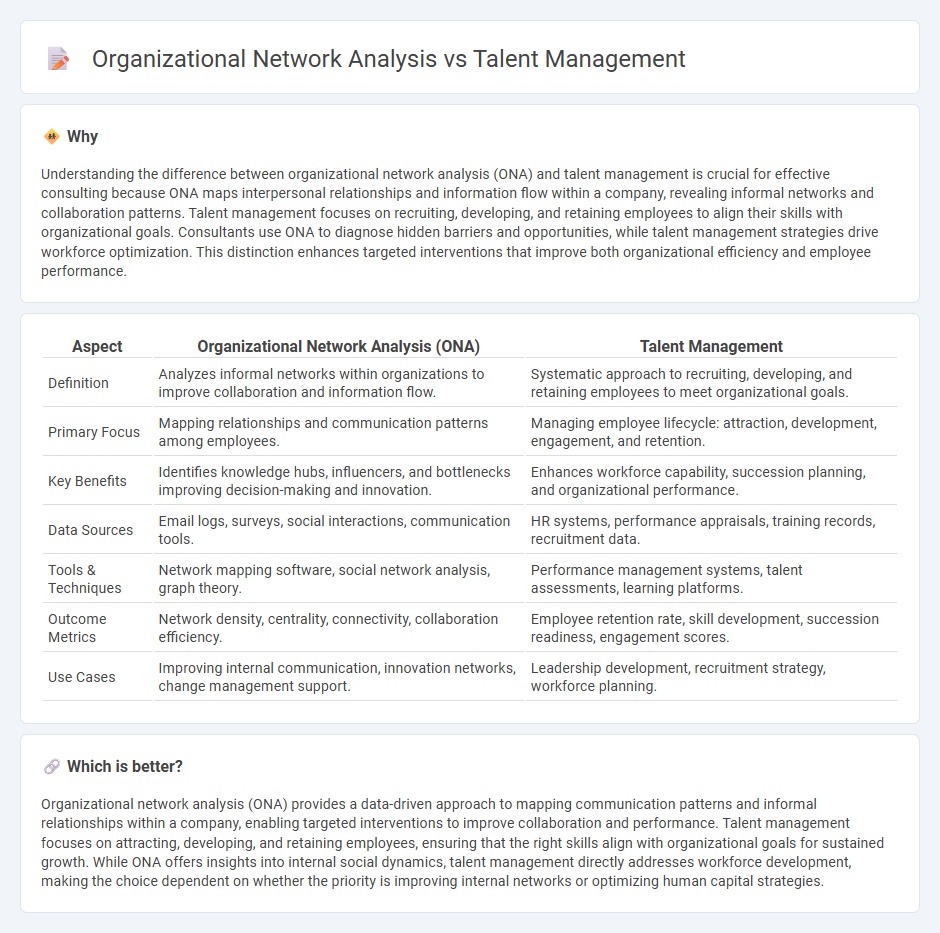
Organizational Network Analysis (ONA) maps informal relationships within a company, revealing collaboration patterns and knowledge flow that enhance decision-making and innovation. Talent management focuses on recruiting, developing, and retaining skilled employees to align workforce capabilities with business objectives. Explore how integrating ONA with talent management strategies can optimize organizational performance and employee engagement.
Why it is important
Understanding the difference between organizational network analysis (ONA) and talent management is crucial for effective consulting because ONA maps interpersonal relationships and information flow within a company, revealing informal networks and collaboration patterns. Talent management focuses on recruiting, developing, and retaining employees to align their skills with organizational goals. Consultants use ONA to diagnose hidden barriers and opportunities, while talent management strategies drive workforce optimization. This distinction enhances targeted interventions that improve both organizational efficiency and employee performance.
Comparison Table
| Aspect | Organizational Network Analysis (ONA) | Talent Management |
|---|---|---|
| Definition | Analyzes informal networks within organizations to improve collaboration and information flow. | Systematic approach to recruiting, developing, and retaining employees to meet organizational goals. |
| Primary Focus | Mapping relationships and communication patterns among employees. | Managing employee lifecycle: attraction, development, engagement, and retention. |
| Key Benefits | Identifies knowledge hubs, influencers, and bottlenecks improving decision-making and innovation. | Enhances workforce capability, succession planning, and organizational performance. |
| Data Sources | Email logs, surveys, social interactions, communication tools. | HR systems, performance appraisals, training records, recruitment data. |
| Tools & Techniques | Network mapping software, social network analysis, graph theory. | Performance management systems, talent assessments, learning platforms. |
| Outcome Metrics | Network density, centrality, connectivity, collaboration efficiency. | Employee retention rate, skill development, succession readiness, engagement scores. |
| Use Cases | Improving internal communication, innovation networks, change management support. | Leadership development, recruitment strategy, workforce planning. |
Which is better?
Organizational network analysis (ONA) provides a data-driven approach to mapping communication patterns and informal relationships within a company, enabling targeted interventions to improve collaboration and performance. Talent management focuses on attracting, developing, and retaining employees, ensuring that the right skills align with organizational goals for sustained growth. While ONA offers insights into internal social dynamics, talent management directly addresses workforce development, making the choice dependent on whether the priority is improving internal networks or optimizing human capital strategies.
Connection
Organizational network analysis (ONA) reveals hidden relationships and communication patterns within a company, providing crucial insights for talent management strategies. By mapping informal networks, ONA identifies key influencers, collaboration bottlenecks, and knowledge hubs to optimize talent deployment and development. Integrating ONA with talent management enhances succession planning, leadership development, and employee engagement.
Key Terms
Succession Planning (Talent Management)
Succession planning in talent management strategically identifies and develops high-potential employees to ensure leadership continuity, emphasizing skill gaps and career pathing. Organizational Network Analysis (ONA) complements this by mapping informal relationships and influence patterns, revealing hidden leaders and collaboration bottlenecks critical for effective succession strategies. Explore how integrating ONA enhances succession planning outcomes and strengthens leadership pipelines.
Social Network Mapping (Organizational Network Analysis)
Social Network Mapping in Organizational Network Analysis (ONA) identifies informal relationships and communication patterns, providing deep insights into employee interactions and influence beyond traditional hierarchies. Talent management leverages these insights to enhance collaboration, identify key contributors, and optimize workforce capabilities. Explore how integrating ONA with talent management transforms organizational effectiveness and decision-making.
Workforce Analytics
Talent management focuses on attracting, developing, and retaining high-performing employees to enhance organizational effectiveness, while organizational network analysis (ONA) maps and analyzes informal relationships and communication patterns within the workforce to uncover hidden influencers and collaboration bottlenecks. Workforce analytics integrates data from both approaches to deliver actionable insights on employee performance, engagement, and social dynamics, optimizing talent deployment and business outcomes. Explore the intersection of talent management, ONA, and workforce analytics to maximize strategic human capital advantages.
Source and External Links
Talent Management: The Complete Guide - AIHR - Talent management encompasses all HR processes to attract, develop, motivate, and retain high-performing employees, aiming to drive organizational performance through integrated people management practices.
Talent Management - OPM - Talent management ensures organizations have the right people with the right skills in the right roles at the right time, supporting strategic goals, workforce development, and retention to achieve mission outcomes.
What Is Talent Management? - Association for Talent Development - Talent management is the strategic practice of acquiring, onboarding, developing, retaining, and transitioning employees to build organizational culture, engagement, and capability, aligned with business objectives.
 dowidth.com
dowidth.com